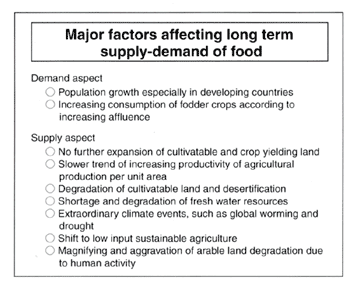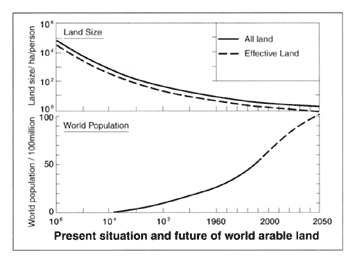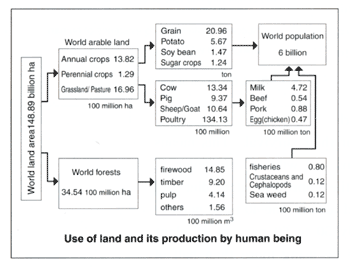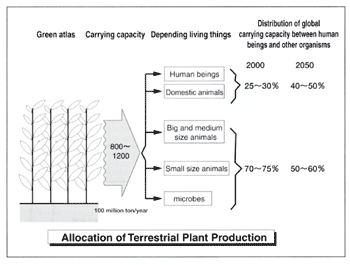|
About 2,300 species of crops are known to be under cultivation in the world today, although we are only able to see about 10% of them. Since there are approximately 300,000 plant species that have scientific names, the crops that support our lives can be regarded as the elites of the plant world. One can safely conclude that the history of human agriculture consists of selection, fostering and improvement of these crops.
Fig(4)
In particular, the 15 species of crops that I have listed here − wheat, maize, rice, potato, barley, soybeans, sweet potato, cassava, sugar cane, sorghum, oat, rye, peanut, bean and beet − are 80 to 90 percent responsible for supporting the world's 6.1 billion population today.
As you can see from this figure, the crop species supporting our lives − the lives of 6.1 billion people − are extremely limited.
Now let us take a look at the volume of crops we are producing by using these crops and advanced agricultural technology. Total land area in the surface area of Earth is 14.889 billion hectares. Among them, about 1.38 billion hectares are used for growing annual crops, 129 million hectares for growing perennial crops and 2 billion hectares for grazing meadows. All of these combined amount to over 3 billion hectares. Two billion tons of grain, 567 million tons of potatoes, 150 million tons of soybeans and 120 million beans are grown on these lands. Growing these crops and using some of them to raise livestock keeps the world population of approximately 6.1 billion alive.
| (拡大画面:83KB) |
 |
Table(6)
On the other hand, we obtain 80 million tons of fish, 12 million tons of shellfish and molluscs, and 12 million tons of seaweed from the vast surfaces of the sea. In addition, we use the amount of wood shown in the figure every year from 3.454 billion hectares of the world's forests so that we can live a civilised life in abundance.
From this viewpoint, it is possible to roughly determine the wide variety of purposes we have for the plant production from terrestrial plants.
Another important question we need to ask ourselves is the major factors that may influence the supply and demand of our food in the near future. Firstly, in terms of demand, there is a problem of population growth taking place mostly in the developing countries. Secondly, there is a problem of feed crop consumption accompanying increase in abundance. In terms of production, cultivated area and grain harvest area are already starting to level off.
| (拡大画面:53KB) |
 |
Fig(5)
Thirdly, the increase in growth of yield per hectare has been slowing down particularly in the recent years. Fourthly, desertification is advancing owing to deterioration of farmland and overgrazing of livestock. Fifthly, there is a problem of tightening and deterioration of freshwater resources. Tightening of freshwater resources will become a very serious problem in many of the developing countries located in the semi-arid region. The next potential problem is that of intensifying unusual weather caused by global warming among others that are predicted to continue in the future. On the other hand, there is heightened interest in environmentally sound farming methods and transition to such methods in the developed countries. Lastly, there is a problem of expansion and intensification of deterioration in farmland environment owing to human activities, which makes it very difficult to simply project the previous trends into the future when forecasting the future increase in food production.
| (拡大画面:49KB) |
 |
Fig(6)
Soil is one of the problems related to spreading and intensified deterioration of farmland environment caused by human activities. According to previous calculation, we are currently using 1.5 billion hectares as farmland. However, only 30% of this land has truly good environmental conditions and fertile soil. Environment is not very suitable in the remaining 70%. While many people involved in agricultural development claim that there is room for developing additional 1.7 billion hectares of farmland, the proposed sites for farmland development are located in extremely poor natural environment.
| (拡大画面:104KB) |
 |
Fig(7)
Factors contributing to poor environment include steep slope, poor soil, soil contamination, poor drainage and precipitation shortage (being located in arid zone). For this reason, developing the remaining 1.7 billion hectares of proposed sites for agricultural production would be accompanied by considerable difficulty.
Another important fact is that these proposed development sites offer safe habitat for many wildlife and produces its own vital energy.
It is also important to pay attention to the land area per person for the humanity as a whole. As I mentioned earlier, we only have 14.88 billion hectares of land area including the Antarctic Continent and Gobi Desert. Since the world population is estimated to reach 9.3 billion by 2050, land area per person would amount to about 1.5 hectares. However, the area is reduced to 0.75 hectare per person after taking into consideration the fact that only half of this land has climatic and soil conditions that are suited for plant growth. This 0.75 hectare is about the same land area as the area of land we are currently using for food production. This suggests that agricultural production will be facing an absolute shortage of land resources by the year 2050.
| (拡大画面:96KB) |
 |
Fig(8)
Another important issue is that of allocation of plant production on land. The volume of terrestrial plant production which takes place on the 14.889 billion hectares of land area is estimated to reach between 80 and 120 billion tons a year and distributed among humans, livestock, poultry, large and small animals, and microorganisms. In other words, carrying capacity of Earth is determined based on this output of 80 to 120 billion tons a year.
Fig(9)
According to our estimate, humans, livestock and poultry are already using 25 to 30 percent of global plant production for their survival. This means that 70 to 75 percent are currently left for other organisms and wildlife. However, at population of 9.3 billion in 2050, taking into consideration the improvement of diet and increase in GNP, humans, livestock and poultry are predicted to consume 40 to 50 percent of global plant production for their survival, leaving only 50 to 60 percent of plant production for wildlife. This means that humanity would be using more than half of global plant production, i.e. Earth's carrying capacity. These figures show that this planet Earth − a place that has already become a difficult place to live for wildlife, our companion with nearly 4.0 billion years in history of evolution − would become an even more difficult place to live and that there is a possibility that mass extinction comparable to that which occurred during the Cretaceous period 65 million years ago would occur again.
I think that how we may be able to avoid this is the great challenge facing all of us living in the world today and the people that will be living in this world in the future.
What are the biggest constraints for our food production in the near future? Global environment is one of them. However, I think that the greatest constraint that determines food production is the adequate allocation of the carrying capacity of the Green Atlas between humans and wildlife.
If we succeed in adequate allocation of the carrying capacity of the Green Atlas, we should be able to realise a sustainable symbiosis between humans and wildlife. If we fail in this endeavour, a massive extinction of wildlife would occur.
From this perspective, the issue of population is not just an issue for us human beings, but a major issue for all forms of life that survived much longer history of evolution than humanity. I think that our lifestyle holds the key to their existence.
|